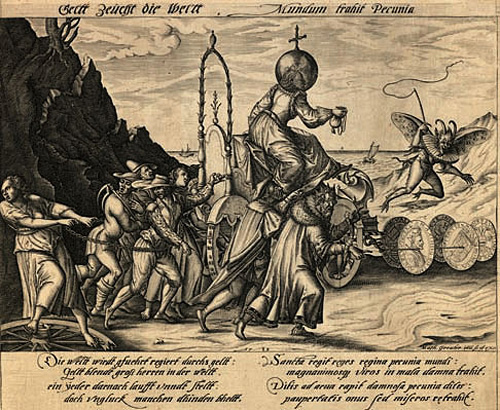The legend on the engraving Gellt Zeucht die Weltt, below, sums up the message of the exhibition Coin and Conscience: Popular Views of Money, Credit and Speculation at the Harvard Business School’s Baker Library. In German and Latin, it may be translated thus: “The world is led and ruled by money: money blinds great men in the world. Everyone pursues it: yet misfortune holds many back.”
The exhibition samples the library’s Bleichroeder Collection of more than a thousand prints depicting stock exchanges, speculators, usurers, and other money matters. Thirty images are on view in the library’s lobby through May 22, and 70 may be examinedclosely, with zoom technologyin a virtual exhibition produced by Outreach Program leader Karen Bailey and mounted indefinitely at www.library.-hbs.edu/-hc/cc. Those 70 are featured in an on-line exhibition catalog by Ruth Rogers, special collections librarian at Wellesley College. She writes: “Through three centuries and six countries, from admonishing biblical allegory to scathing political cartoon, the images shown here resound with the same message: where there is money, there is power, vice, corruption, and misfortune.”
Photographs courtesy of Baker Library, Harvard Business School
Above: Gellt Zeucht die Weltt. Mundum Trahit Pecunia, engraved, designed, and published by Mathias Greuter, Strasbourg?, 1589. The World is borne on a chariot whose wheels are gold coins. Two noblemen blinded by money walk alongside. Poverty, standing on the Wheel of Fortune, holds back the lower orders. A “money devil” cracks the whip.

Above: Midas, Transmuting All into Gold Paper, etching by James Gillray, London, March 9, 1797. Prime minister William Pitt spews paper money out of his mouth while gold coins are safely hidden in his stomach. When the Bank of England announced a gold shortage, owing to loans it had made to finance a war with France, Pitt implemented the issue of paper money. But rumor had it that the bank’s coin was being held in reserve to send to the Continent to support the war.

Above: Ni l’Un ni l’Autre, etching by Friedrich Fleischmann, after Jenny Berger, Nürnberg, early nineteenth century. One tempter offers money, the other, jewels.

Above: Le Grand Diable d’Argent Patron de la Finance, hand-colored etching, artist unknown, France, early nineteenth century. People of all trades pursue the flying money devil. Many thematically similar prints were published during a period of 150 years. Some had verses to be sung to popular tunes.





